Chris & Allyson vs. Alaska (2016)
Chapter Two: Ketchikan
Ketchikan is the fourth-largest city in Alaska, depending on the time of year. When cruise ships are docking, about 14,000 people live there. When it's a godforsaken frozen wasteland, about 9,000 people stick around.
Our zip code in DC has about 39,000 people, rain or shine.
The point is, Alaska is enormous and tiny at the same time. Ketchikan is the "gateway" to a state that covers 663,000 square miles -- compared with our 2.2 square mile zip code -- but you can see almost all of it from the deck of a cruise ship. We did just that, after enjoying a little breakfast in the ship's buffet cafeteria. Bears didn't seem to be mauling people in the streets, so we got our things together and stepped on Alaskan soil for the first time.
You gotta like Ketchikan, which is one of Alaska's oldest white person cities. When Alaska was first getting settled by white people, their focus was on the southeast part of the state. It made more sense for fishing, and for shipping, and for not dying on the side of a 20,000-foot mountain. The natives in that part of Alaska, the Tlingit, were slow to catch on to the fact that white people were the human equivalent of the ebola virus. So they helped the newcomers adapt to the harsh realities of their new home.
Today, the Ketchikan tourism brain trust calls the city the "Salmon Capital of the World," and to emphasize that point they put a triumphal arch at the intersection closest to the middle of the cruise ship docks. Leaving the ship, we walked right under the arch on our way to exploring the other dozen intersections in town.
You can do a lap of "downtown" Ketchikan in about 10 minutes. We looked at the town salmon ladder, which was empty. We spied the offices of the Ketchikan Daily News. And we did a quick walkthrough of Creek Street, which is the historic district where all the whores used to live. This would all have to wait, however, because it was time to do some kayaking.
When you go to Alaska, there's a vast frontier of natural wonder awaiting you. Of course, you probably aren't willing to carry a 100-pound pack over a 10,000 foot mountain pass while being actively hunted by a series of mammals that outweigh you by at least two-to-one. Remember, the state is actively trying to kill you at all times, and if you aren't willing to dance that tango, the possibilities of Alaska are whittled down to few basic options. You can eat something, find out about native Alaskans, look at animals, or look at scenery. Once the activity is decided, you choose some mode of transportation: hiking, train, horse, ATV, kayak, jeep, zip line, small boat, large boat, dog sled or bus. Mix and match, and you've got yourself a vacation.
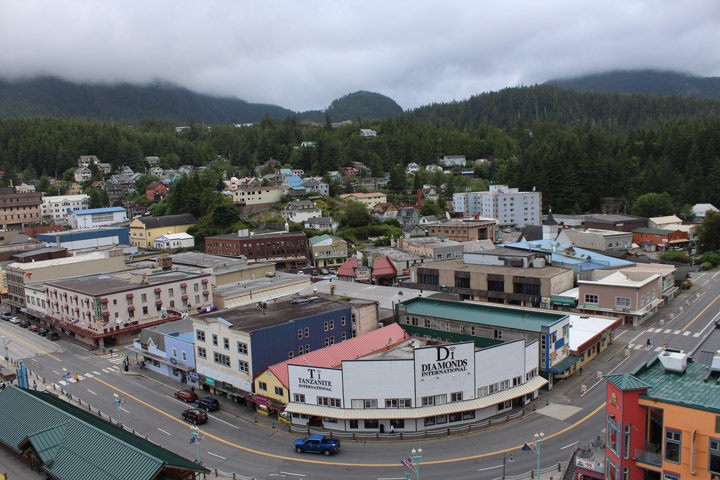
A view of Ketchikan from the highest point -- the deck of the cruise ship.
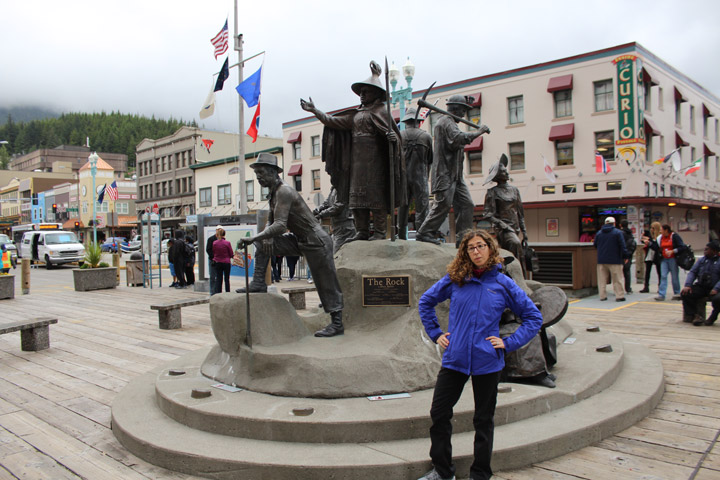
Posing in front of a monument on the Ketchikan dock.
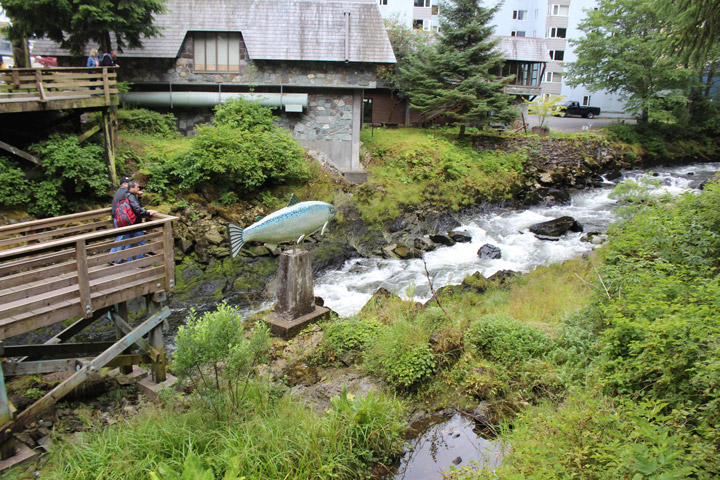
Ketchikan's salmon ladder, a nod to the city's fishing history.
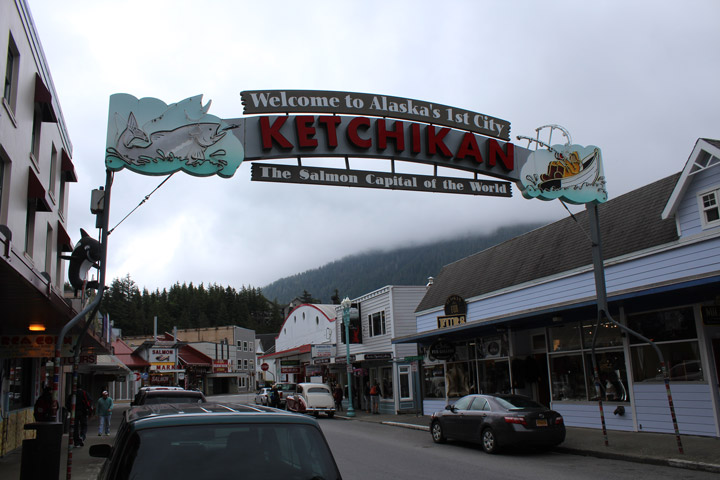
As triumphal arches go, it's not a bad one ...
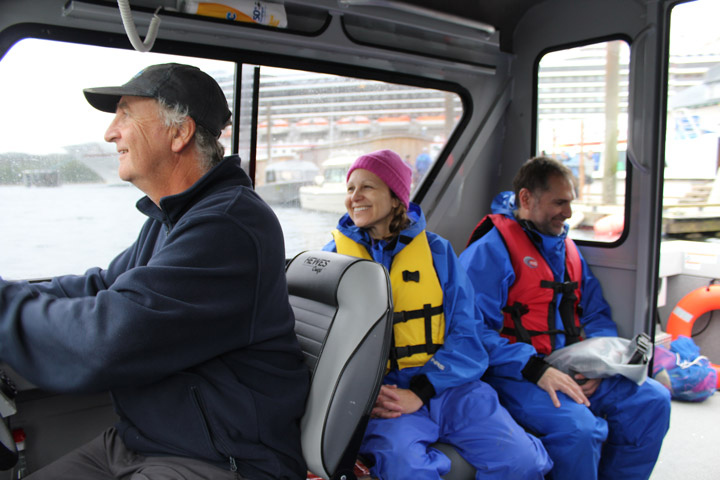
Heading out for some ocean kayaking with Yuval and Brenda.
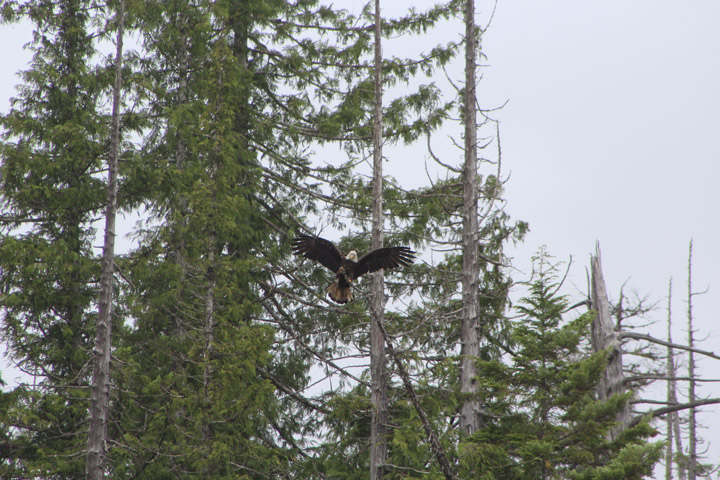
An eagle. At the time we thought this was cool and not ordinary for Alaska.
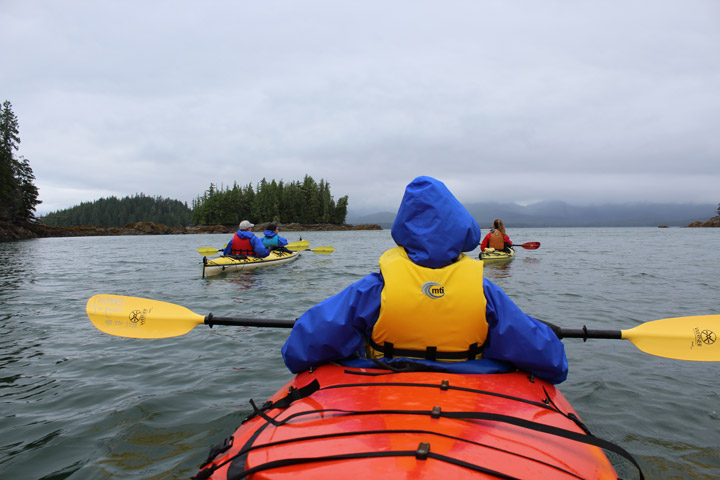
The view from the back of a tandem kayak.
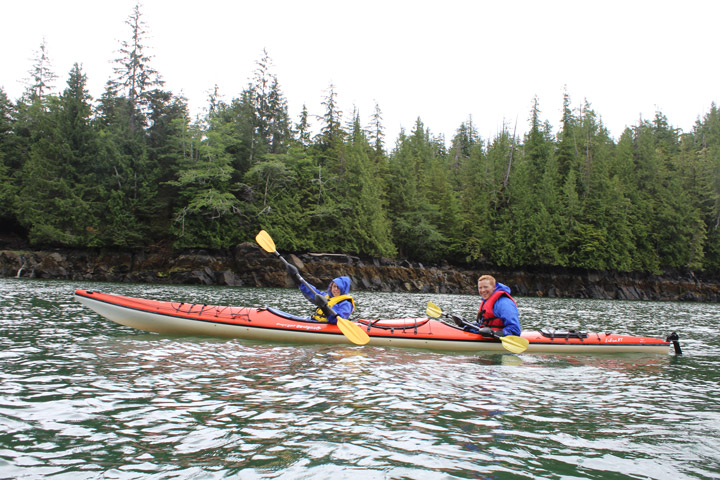
Rugged outdoorsmen doing their thing.
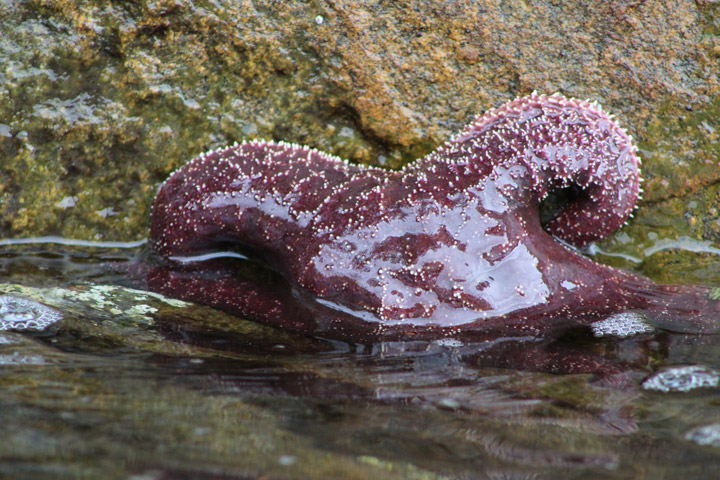
A starfish frolicks in the waters off Ketchikan.
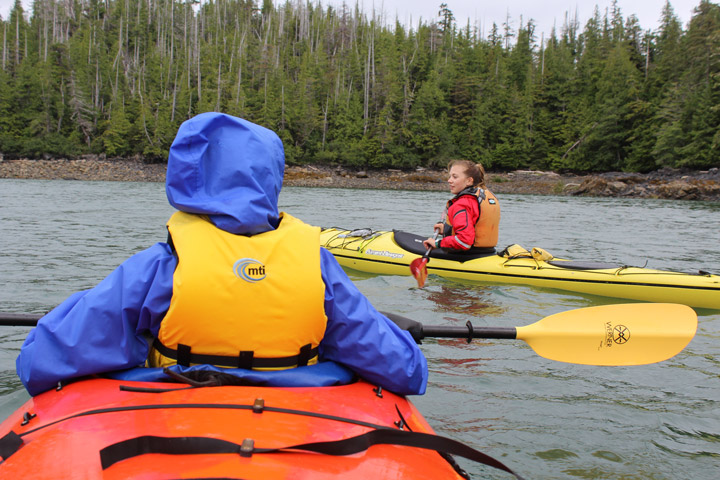
Natasha, our very young (and very good) kayak guide.
Kayaking was high on my Alaska "to do" list. I try to get out on the Potomac River at least once a year to splash around. It's an activity that can make me seem manly, as long as I avoid whitewater and the crying that would come with it. Plus, I saw "Nanook of the North" in high school, and they were all over the kayaking in that one. Allyson did not have kayaking on her "to do" list, because she has a bad back. But she knew it would make me happy, and I promised to sit in the back of a two-person kayak and do all the work. Marriage is sort of about compromise sometimes.
The outfit we found online promised to take us ocean kayaking in a place called Orca's Cove. It also promised that our group would be no more than six people. So naturally, even with a few cruise ships in town, two of those people were Sherrie and Evan, the couple we met during the Millennium's muster drill. We ran into them at the designated meeting spot, right next to the cruise ship, in front of Ketchikan's "liquid sunshine" gauge. This is a pole indicating the various rainfall records for Ketchikan, where it rains all the time. They probably put it right next to the cruise ships to keep expectations low.
So naturally, it was raining.
The final pair was Yuval and Brenda, a very nice couple from Montreal. They showed up on time, and were told by the guide that they weren't on the list. So they walked away. A few minutes later, the guide found the second page of the list, then quickly hunted them down. As we were about to brave orca-infested waters with this guide, we were a little concerned by this first impression. And if we're being honest, it didn't help that the guide seemed to be a 15-year-old girl.
First impressions can't always be trusted, because Natasha was fantastic. She was an 18-year-old girl from Ketchikan. Chatting with her over the next few hours, we learned that "kayak guide" was her summer job, which was helping her raise money for her upcoming freshman year at a school in Colorado.
This was an interesting choice for a teenage summer job. Personally, I worked two summers in a movie theater, while Allyson worked in a deli. Natasha took personal responsibility for the lives of out-of-shape tourists braving the open seas. As a teenager, I drove a Ford Crown Victoria owned by my parents, and not all that well; Natasha owned a few boats and had been kayaking for most of her life. For gym class, I played ultimate frisbee with a kid who wore a tri-corner hat to school every day. Natasha had survival training. At some point, she was dropped off in the woods and told to make it out. Natasha had to figure out which berries and animals might kill her.
And she also knew how to kill animals! It came up in casual conversation that she had some kind of state record for shooting a very big mountain goat. Alaskans grow up fast, and every company in America should be hiring 18-year-old Alaskans as interns just as fast as Alaska can produce them. It would really help the global economy.
After a quick walk to the dock, they gave us some bright blue wet-weather gear, which keeps you dry AND makes it easier for rescue crews to spot your floating corpse a few hours later. Then a very nice Australian boat captain named Glen shuttled us out for 20 minutes to the spot known in tourism brochures as Orca's Cove. The company had another boat there -- this time, a floating base where all the kayaks were moored. We transferred over and got some quick verbal instructions on using an ocean kayak. Then, they showed us how to hook up a "sea spray skirt." That's the very important pseudo-garment that wraps around your torso and seals around the opening in the kayak, making you look like a person who lost their legs to an orca and is desperately paddling the seas for revenge. It also keeps the inside of your kayak kind of dry, so you can take your $500 camera with you while suffering only minor heart palpitations.
After seven minutes of training, we were clearly ready for the water. This was our first time in an ocean kayak, and it took some getting used to. Allyson was in the front, and I was in the back, as promised. She couldn't turn around and look at me, and I couldn't hear anything she was saying. Cynical people would call that win/win. The kayak has a rudder which is operated by foot pedals, and for a two-person kayak the pedals are in the back. You push your left foot forward when you want to go left, and vice versa. It's a wonderful and easy system, and the only flaw is that it doesn’t work when the water is even slightly choppy, or the wind is blowing more than 1 mph.
At least, it didn't work for us. Natasha was zipping around like a speedboat during a James Bond chase sequence.
Fortunately, there wasn't too much liquid sunshine that day. It was overcast and drizzly, but Orca's Cove is a little bit sheltered. Once we figured out how not to crash the kayaks, Natasha took us around the block. We saw starfish gripping the rocks and moon jellys floating just below the surface. A few fish were jumping out of the water -- July is the middle of humping season for Alaskan fish. Some large pieces of kelp drifted past. They looked like huge green sperm. A harbor seal was chilling out on a boulder, and we even saw a few black-tailed deer picking their way along the coastline. Under Alaskan law, every tourism outing must feature at least one bald eagle, so we also got to see a few of them hanging out in the nearby trees. The only thing missing was orcas.
But there was some adventure, when we ventured a little outside of the cove to look at some tribal art on the side of a cliff. At that point, the wind picked up, and Yuval, Brenda, Sherrie and Evan all got carried 200 feet out into the main waterway. They would have hit the shipping lanes if not for the swift rescue mounted by Natasha. Allyson and I somehow managed to stick close to the coast, and we muddled our way back the cove after only four minutes of desperate paddling. It's a very tricky situation, when you promised your wife that you'd do all the work in the kayak, but you also don't want to have your corpses drift ashore in Japan three weeks later. My advice is to paddle really hard and hold your tongue until it's absolutely certain that you're about to die.
When we got out of the kayaks and back on the "base" boat, the company provided us with a delightful snack of smoked salmon, cheese and crackers. We chatted a bit with the other couples and agreed that we all had a good time despite not being particularly good at ocean kayaking. (Another five or six years of intensive practice and we might have mastered it.)Then we transferred back to the original boat, rode back to the dock and turned in the waterproof gear and said goodbye to Natasha. And at that point, we had some time to kill in Ketchikan. Ocean kayaking is all you really need to have a memorable day of vacationing, but that's not how we party.
In 1923, a few days before he died, Warren Harding became the first sitting president to visit Alaska. He remains the only sitting president to visit Ketchikan. This was a big deal to the Ketchikanians. (Ketchikaners? Ketchikani?) In a city where streets are at a premium, there are no less than THREE named to honor the 29th president. One is Warren Street. It ends at the intersection with G Street, which runs all of 60 or so feet to the intersection with Harding Street.
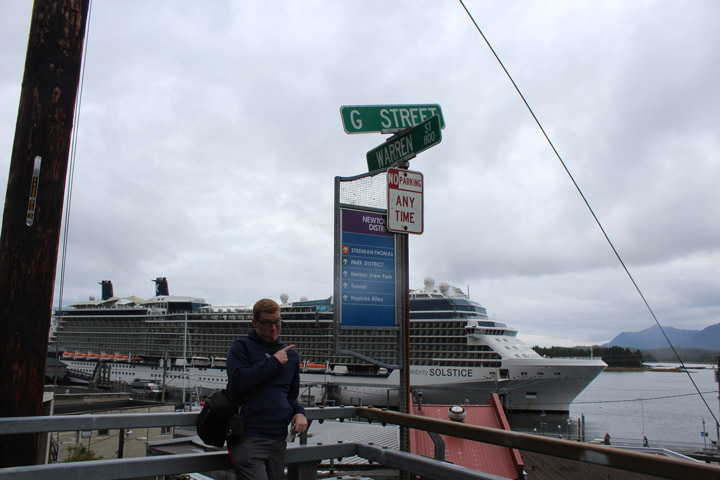
Alaska's very little bit of presidential history.
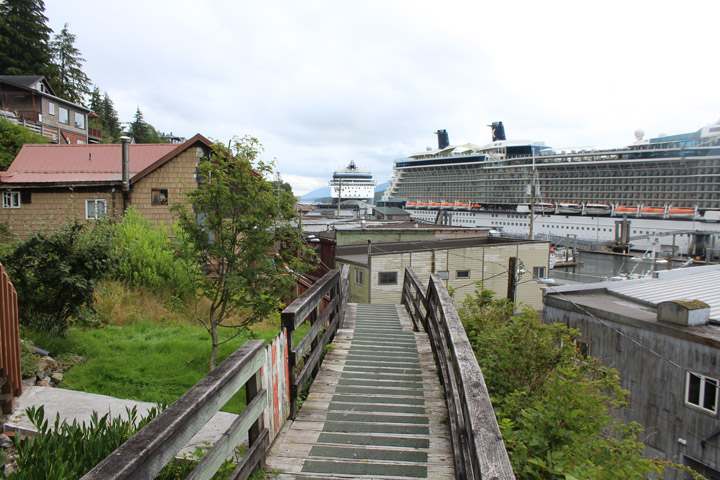
The ship is bigger than the town.
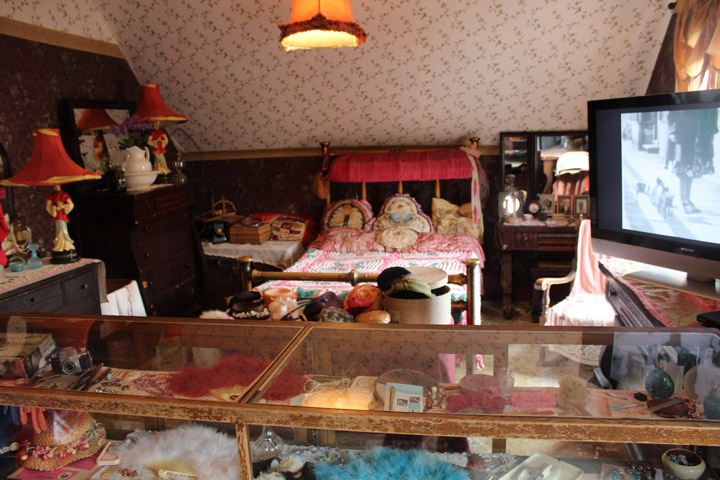
The bedroom / office at Dolly Arthur's house, the best little brothel in Ketchikan.
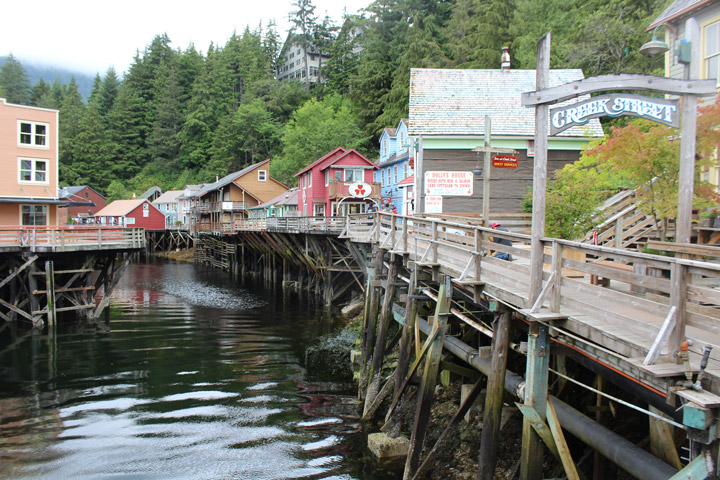
Creek Street: Once a hive of villany and illegal activity. Now a tourist attraction!
I love presidential history, and this was the extent of what we were going to get in Alaska – as you may recall, the 2008 election didn't quite go Alaska's way. Allyson is a great wife, so she agreed to walk from the docks to the greatest intersections in the Last Frontier. The three streets are residential, with the homes built on a steep hillside. The homes look like they've been severely abused by the non-stop rain and snow of Ketchikan, and the general vibe is that someone might come out on their porch to shoot you at any moment. The homeowners are probably fed up with the millions of Warren Harding fans trampling through their lawns, although we were strangely the only ones there at the time. We got our pictures, then went back to take a second look at Creek Street.
As mentioned earlier, Creek Street is known as the whoring district. In the early days of Alaska, the male-to-female ratio had to be brutal. Men dominated the mining, shipping, fishing and organized crime industries that were the bedrock of the territory's economy. A few of those industries also involved men spending a lot of time at sea. So if you know your history, you can appreciate that every Alaska town had plenty of whoring.
The creek in question is Ketchikan Creek, which comes down from the coastal mountains and empties into the harbor. It was lined with buildings on stilts, which were connected by boardwalks. Salmon would run upstream in the summers, and the dead bodies of murdered scuzzballs would float downstream almost any time of year.
Today, it's a cleaned-up historic district. Most of the buildings have been converted to boutique shops, but it is still a great place for the children of today to learn about whoring and murdering.
We started on the upstream end of Creek Street, where the Married Man's Trail comes in. That was the more-discreet wooded path that respectable townsfolk would use when heading out for an evening of illicit sex with whores. After a pleasant stroll downstream, we arrived at the Dolly's House Museum. Dolly Arthur (b. 1888) came to Ketchikan in 1919 and became a pillar of the community, although most pillars are not horizontal quite so much. Without the protection of a pimp, Dolly ran the most successful brothel in Ketchikan, with basically only herself as an employee. She was a sex worker until age 72, and she died in the 1970s.
Dolly is understandably a source of great civic pride, and for $5 you can have an enthusiastic guide in old "working girl" garb show you around the house. In Dolly's time, the same fee would have gotten you a $3 trick and four 50-cent shots of bootleg whiskey, but there's really no point in complaining about inflation. Allyson loves learning about criminal enterprises -- it's one of her charms -- so this one was a no-brainer. It's not a huge tour, and the house is probably more domestic than you're imagining. Dolly liked her kitchen, and her taste in decor seems kind of like your grandma's. Remember, they were contemporaries, although your grandma probably had less illegal sex in her lifetime.
But there are also some nice flourishes, like the water heater Dolly converted to a urinal for her patrons, and the tiny bar hidden under the steps, where Harry Potter would have lived. The shower curtains in the master bathroom are decorated with unused silk condoms, which prostitutes quickly determined were ineffective. Instead, we learned, they often stuck silver coins in their lady areas, to take advantage of silver's antibiotic properties. This turned their lady parts blue. I assure you, all their suffering was worth it, for it gave me the chance to watch Allyson's face when we heard the silver dollar story. The most imposing room in the house has to be Dolly's bedroom, which you could also call "the office." If those walls could talk, they'd probably have a very popular podcast by now.
We went back to the ship after the tour, because cruise companies are very insistent that you be on board when they want to leave. We both did some light reading, and we watched the fantastic scenery glide past as we headed north during dinner. The evening entertainment in the Millennium theater was an Elton John tribute artist. He was pretty good, and he kicked off two weeks of us hearing an Elton John song almost every day. The colder temperatures in Alaska have apparently preserved the music of the 1970s and 1980s.
On returning to our room, we were thrilled to spot a whale from our balcony. At that point in the trip, we didn't yet know that ONE whale was chump change. But we were going to learn, quickly.
